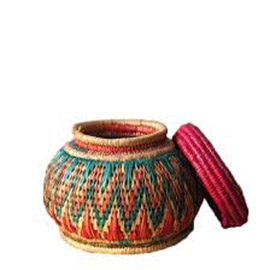
Sikki or Golden Grass craft is distinguished by its intricate weaving and coiling techniques, where artisans skillfully manipulate the flexible nature of Sikki grass to create a range of products. The process typically begins with harvesting Sikki grass from marshy areas during specific seasons when the grass is at its most flexible and durable. After harvesting, the grass is dried, sorted, and cleaned before being dyed using natural pigments derived from plants, roots, and seeds. This dyeing process not only adds vibrant colours but also enhances the grass's durability and longevity. Artisans then weave or coil the grass into various forms such as baskets, trays, mats, coasters, and even intricate figurines and wall hangings. The weaving techniques vary from simple to highly complex, often incorporating traditional motifs and patterns that reflect local cultural heritage. One of the unique aspects of Sikki grass craft is its adaptability. While traditionally used for practical items like storage baskets and mats, contemporary artisans have expanded its application to include innovative designs and modern aesthetics, catering to a broader market both locally and internationally. Overall, Sikki grass craft is not just about creating functional items but also about preserving traditional skills, promoting sustainable practices, and celebrating the rich cultural legacy of Bihar's artisan communities.
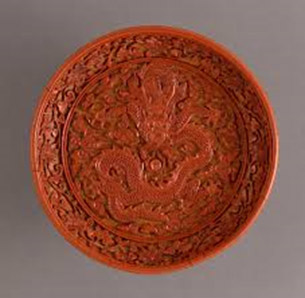
Bihar lacquerware is a traditional craft from Bihar, India, renowned for its intricate designs and vivid colours. Artisans use natural lacquer, derived from the resin of lac insects, to coat wooden or bamboo objects. They mix lacquer with natural pigments, applying multiple layers and polishing each meticulously to achieve a glossy finish that enhances the underlying patterns and colours. This ancient craft has been integral to Bihar's cultural heritage, producing items like decorative boxes and bangles for centuries. One such celebrated piece is the Sindurdan, a vermilion container gifted during marriages, crafted by the Laheri community. These containers are beautifully adorned with motifs like fish, chakra, and peacocks, symbolizing fertility and longevity. Traditionally, the bride's family presents her with a round, tapered box adorned with auspicious symbols upon marriage, symbolizing prosperity and enduring happiness, etched onto its vibrant red surface.
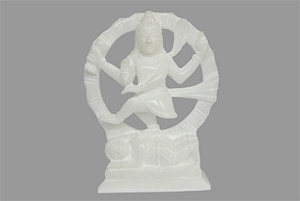
Stone carving is a very ancient tradition in Bihar. The craft achieved its zenith during the Mauryan period and its finest examples are the rock-cut caves of Barabar and Nagarjuni Hills in Jahanabad District. Various stupas and monasteries stand as the great exhibits of the excellent artistic quality of the artisans of Bihar. Amongst the most famous stone carvings of Bihar are the Ashoka pillars at Lauria Nandangarh and Koluha, along with Mundeshwari Temple Complex of Gupta period. This art is practiced at Patharkatti in Gaya district. It is one of the major centres of stone craft in Bihar. The basic raw material used in this craft is marble and Granite. The craft has not only been associated with religion and deities but also focuses on making household items such as thali and bowls. The Gaya town of Bihar presents a huge variety when it comes to stone craft. The process of making stone craft is very much different than all other art and crafts. Firstly, the stones are selected by the people and then the shape of the idol is carved on the stone according to the need and preferences. The waste parts are then dismantled and thrown away. In ancient times this work was carried on with the help of a chisel hammer, but with the help of new inventions like drillers, molding machines, and cutters the work nowadays is finished at a much faster pace. However, it requires experience, great eyesight, and tons of patience, as one little mistake could lead to a loss of thousands. This is a unique product handcrafted by artisans. Other centres of the stone craft in Bihar are in Nalanda, Kaimur and Patna.
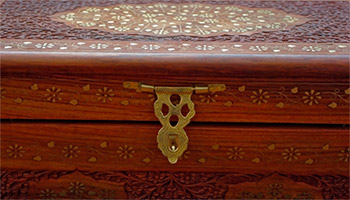
Wood inlay is ancient art of Bihar and continuous to be practised, with different materials like metal, ivory, stag horn, and chips of different wood being used. Wall plaques, table tops, pens, and paper cutters are among the items made from wood inlaid with diverse materials. The diaper work utilises waste pieces of wood to make boxes and trays. A common motif is the pipal tree, symbolic of enlightenment is found in abundance in Bihar and, thus, lacquerware is very popular. It also has ritualistic value. The vermilion container used at marriages is made of lac. A community called laheris makes these round or oval shaped containers called sindurdans. Fish, chakras, and dancing peacock are used as embellishments. A nose ring box often given to a bride at her wedding is a round conical ceremonial box with symbols of fertility and longevity engraved on its red body. Magadh is famous for making singhasanas (thrones), and door and wood panels. Furniture in traditional designs is also being produced with traditional motifs being used modern furniture.
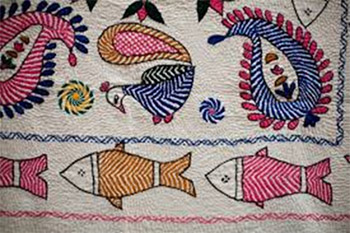
The name Sujini finds its roots in the word Sujani where Su means “easy and facilitating” and Jani means “birth”. Traditionally, the Sujini technique was used to put together a quilt from old saris and dhotis for newborn babies. A simple running stitch was used to put the scraps of cloth together and prospective mothers contributed to the design as well by stitching their hopes and dreams for the baby onto the quilt. The earliest traces of this embroidery style can be found in 18th-century Bihar amongst the women belonging to the lower castes. It possibly began as a ritualistic practice in tribute to Chitiriya Ma, the lady of tatters. Sujini embroidery symbolizes the amalgamation of disharmonious pieces of cloth into a harmonious whole. With every piece of cloth affixed to the one preceding it, the act of stitching speaks of the tenderness and care found in a mother’s love. When a baby is swaddled in a quilt built with the Sujini technique, they are not only warm but also protected by the good wishes and prayers that their mother stitched into the foundations of the cloth. The most traditional designs of Sujini embroidery are sun and cloud motifs which are symbolic of the life-giving process. Other common designs include fertility symbols, sacred animals, and mythical creatures embroidered to protect the infant against the forces of evil.
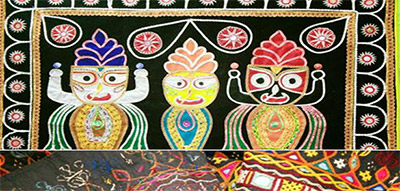
Khatwa is the name given to applique works in Bihar. Khatwa is about designing by cutting of one fabric and stitching the pieces to another fabric. Khatwa is mainly used to create designer tents, canopies and shamianas. Applique is the art of sewing together different smaller pieces of cloth to create a harmonious, single larger piece that is uniquely beautiful. To make Khatwa, the intended design is drawn on both the upper layer of cloth and the base fabric, after which the upper layer is cut roughly into the shape of the pattern or motif, leaving a wide margin. This margin is then segmented with cuts, folded down and stitched into the planned shape. In some cases where the design has only two colours, the upper layer is strategically cut and stitched down to reveal the patterns and motifs through the contrasting colour of the base fabric. Embroidery with a silk thread, in the form of running stitch and chain stich, features prominently in the appliqued designs. The waste cloth may also be naturally dyed before being used for applique, and while a wide range of colours is used, the preferred palette for Khatwa today are earth tones and muted. The Khatwa applique work of Bihar, unique to the Northern districts of the state, employs similar techniques. What is unique about the work is the fact that the applique work is not simply some pretty cloth, but also incorporates motifs, themes and narratives on the lives of artisans and rural life in general. While this craft was historically sold only in and around Bihar, designer brands are picking up on its beauty and bringing it to the global stage. It was granted the GI tag in 2007.
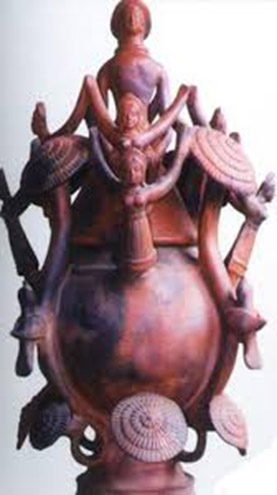
The tradition of clay and terracotta in Bihar dates back to the Mauryan period when hundreds of male and female figurines and animal figures horses, elephants, birds, and reptiles were made of clay and baked. This tradition continued down to the Mughal period. Each village, district, and region has its own style of pottery and of decoration. The some rituals continue to be practised in their original form. The making of toys and images was and is closely connected with seasonal festivals and other religious ceremonies. In the past, clay village gods or gram devtas could be seen outside each village, guarding the inhabitants against bad luck, illness, and the wrath of nature. Clay elephants, signifying marriages, could be seen on the roofs of houses. These figures were not merely religious but also served as toys for children and decorations in bed chambers. Artisans use potters’ wheels to make different shapes by using their own hands. The raw materials used in this craft are Ram-Ras Mitti and Gerua Mitti. After the completion, it is then burned on coal. Sometimes they were hand-modelled, while at other times they were moulded. Today, the potter’s art in Bihar is confined to medium and coarse red wares and the making of dolls and toys on festivals and special occasions.
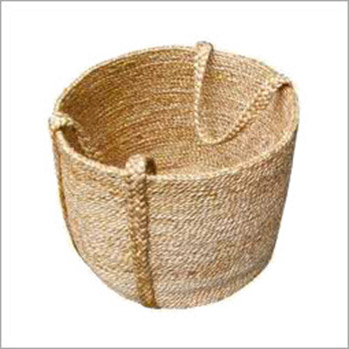
Jute has definitely changed the scene of craft making in India. Alongside Assam, Orissa, Tripura, West Bengal, and Uttar Pradesh, it is also grown and abundantly available in Bihar as well. One can say a lot of labour goes into the making of these products. The fibres are firstly extracted through the process of retting in which all the bundle of jute stems is immersed in running water. After this, comes the process of stripping over where all the non-fibrous matters are scrapped off and all the fibrous parts are grabbed from the jute stems. The jute threads are then gathered together and tied at a point. The threads are then divided into 3 parts and braided by twisting one on top of the other. Once these steps are completed then jute cloth is brought from the market and cut accordingly for the required pattern. These clothes are then stitched together to derive various products like bags, coasters, mats, and many more. A number of products are handmade with simple tools while others are machine-made.
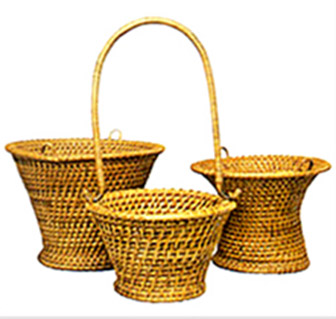
The bamboo and cane crafts of Bihar showcase a blend of historical traditions with modern influences, reflecting the rich legacy of powerful dynasties like Magadha Majanapadas, Mauryan Empire, and Gupta Empire. Artisans in Bihar have flourished with the introduction of modern technologies, enhancing the craftsmanship of bamboo and cane products while preserving traditional roots. These crafts, initiated in prehistoric times, encompass a variety of utility items like baskets, furniture, and decorative pieces, with a focus on sustainability and eco-friendliness. Tribal artisans, particularly the Bhotiyas from the Trans-Himalayan region, exhibit exceptional skills in crafting intricate products that have gained recognition both locally and internationally. The availability of raw materials, favourable weather conditions, and a skilled workforce have propelled the growth of bamboo and cane crafts in Bihar. Artisans prioritize longevity and style in their creations, utilizing various parts of bamboo and cane to make diverse products such as furniture, mats, and storage containers. Essential tools like the bill-hook, knife, and jak, along with saws and other equipment, underscore the precision and dedication required in crafting these art pieces. Overall, Bihar's bamboo and cane crafts stand out for their creativity, sustainability, and blend of traditional artistry with modern techniques.